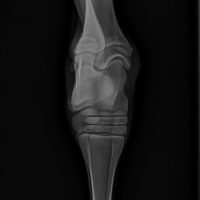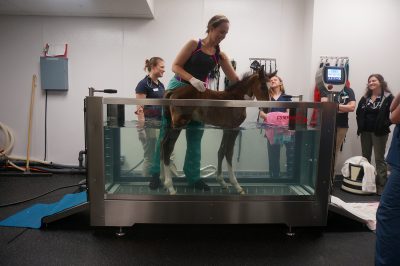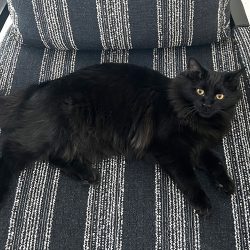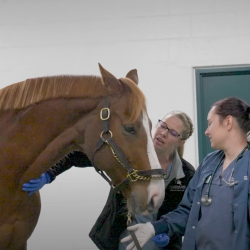You Can Lead a Horse to Water—and Make Him Exercise.
History and Diagnosis


Napoleon, a less than 12-hour-old colt, was presented to the MSU Veterinary Medical Center for further evaluation and treatment due to worsening diarrhea, contracture of his forelimbs, and inability to nurse. Additionally, the mare was noted to have a grossly abnormal placenta. The owners attempted to bottle feed Napoleon at home, but elected to bring him to MSU due to progressive weakness.
On presentation, Napoleon was recumbent and unable to stand, even with assistance. He had profuse, watery diarrhea, abnormal mentation, and a poor suckle response. He was unusually small in size with significant bilateral forelimb contracture and carpal valgus. Initial diagnostics (CBC, venous blood gas, radiographs, and abdominal and thoracic ultrasound) revealed dehydration, failure of passive transfer, evidence of necrotizing gastroenteritis, and grade one (the most severe) incomplete ossification of his cuboidal bones. Based on his history and initial diagnostic findings, Napoleon was diagnosed as dysmature, likely due to his mare’s placentitis, as well as hypoxic-ischemic encephalopathy, presumptive sepsis, enteritis, and flexural limb deformities with incomplete ossification of his cuboidal bones.
Treatment and Outcome

Due to his profuse diarrhea, Napoleon was admitted to MSU’s Pegasus Critical Care facility. He was initially treated with a plasma transfusion, broad spectrum antimicrobials, and intravenous fluids. Because oral nutrition can exacerbate enteritis, causing colic, bloat, and potentially worsening the diarrhea, he was placed on parenteral nutrition. After two days of supportive care, Napoleon’s gastroenteritis improved and diarrhea resolved.
Given the history of bottle-feeding, Napoleon was at high risk for developing aspiration pneumonia. Serial ultrasound examinations revealed ventral pulmonary consolidation consistent with aspiration. Although this required several additional weeks of antimicrobial therapy, he recovered from the pneumonia. Fortunately, he did not develop more serious sequelae of sepsis, such as septic joints, septic physitis, or meningitis.
Weight bearing can cause irreversible damage to the cartilaginous bone precursors, resulting in juvenile arthritis and angular limb deformities leading to career-ending lameness. Napoleon was kept on strict bed rest, requiring that a foal sitter stay with him 24/7 for the first two weeks of life to minimize crushing of these delicate structures.
After two weeks of strict bed rest, fiberglass tube casts were placed on both forelimbs. Tube casts allowed Napoleon to stand for periods of time loading his flexor tendons while minimizing the crushing forces placed on his soft cuboidal bones. Once Napoleon’s bones had developed, Napoleon needed to build up the strength of his muscles, tendons, and ligaments. To do this, Napoleon began walking on an underwater treadmill (hydrotherapy) at the Dr. Elwood and Linda Collins Rehab Center. Napoleon took to the treadmill and quickly mastered walking at varying speeds for 30-minute daily sessions. Within days, his tendons and ligaments began to show signs of straightening and strengthening.
Comments
Foals born to mares with placentitis are at risk for sepsis and dysmaturity. Dysmature foals have characteristics of prematurity (such as incomplete ossification of the cuboidal bones), though their gestation length is normal to prolonged. This condition is thought to be due to a poor intra-uterine growth environment, which retards their development. Neonatal septicemia can result from direct transplacental bacteria transmission or post foaling exposure.
Loss of the mucosal barrier in foals with gastroenteritis can result in bacterial translocation, bacteremia, and sepsis. Colostrum ingestion has a local protective effect against bacterial translocation. In foals with gastroenteritis, history of placentitis, failure of passive transfer, or suspect aspiration pneumonia, rapid intervention with appropriate broad-spectrum antimicrobial therapy is imperative to try to prevent the dissemination of bacteria.
Incomplete ossification of cuboidal bones can be a devastating diagnosis for foals. Even simple weight bearing can result in severe crush of the cartilaginous precursors, leading to crippling juvenile arthritis and compromised quality of life. Previous therapies relied on bed rest and fiberglass tube casts. Unfortunately, casting can result in sores and tendon laxity. When casting a growing foal, careful monitoring is necessary to minimize these complications.
Use of the underwater treadmill allows foals to safely exercise while only bearing a percentage of their body weight on their limbs. Water’s buoyant property results in decreased weight bearing forces on the musculoskeletal system. This property prevents crush of cuboidal bones while allowing continued development and strengthening of muscle, tendon, and ligament.
This past foaling season here at the MSU Veterinary Medical Center, we successfully used hydrotherapy in the management of two foals with incomplete ossification of their cuboidal bones. Both foals were discharged from the Hospital with complete ossification and no evidence of bony damage. Follow up examinations have been encouraging, showing continued normal development without evidence of deformities. More experience is necessary to determine the ideal protocol to maximize the outcomes. We are excited to offer this therapy in cases like Napoleon’s to minimize life-limiting complications and preserve athletic potential.



